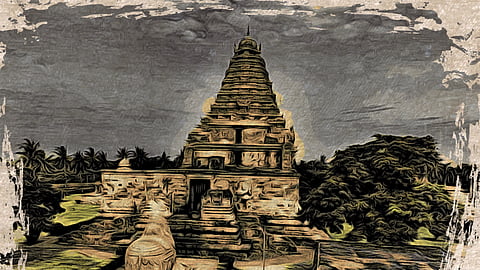- Commentary
- History Vignettes
- Notes on Culture
- Dispatches
- Podcasts
- Indian LanguagesIndian Languages
- Support

I continue where I left off from my last year’s jottings and sincere note of thanks penned when The Dharma Dispatch turned one. The Dharma Dispatch was conceived as and will remain a civilizational good. This platform is an endeavor to try and present the distilled essence of all that is noble, high, virtuous, enduring, and timeless drawn from the timeless annals of the Sanatana tradition, heritage, culture, civilization and history.
For those who came late, we define civilizational good as follows.
Bharatavarsha is the only ancient civilization surviving in an unbroken fashion in a world dominated by two aggressive Abrahamisms, whose core ideas and doctrines continue to wreak havoc on the entire planet in an unprecedented fashion. In any discussion about comparative religions and cultures, it must always be remembered that these two Abrahamisms are not civilisations in the true sense of the word. A very simple definition of civilization is an innate and conscious respect for Nature in all its manifestations and expressions, including the inanimate.
From this perspective, the conception of civilizational good can be defined as any and every activity that helps to sustain, foster, and preserve the sublime and the profound but invisible notions of Rta (Cosmic Order), Satya (Truth), and Dharma (Virtue). Out of these conceptions, the Sanatana civilization evolved practical applications, customs, rituals and traditions to realise their truth in real life. These include but are not limited to Yajna (sharing), Daana (charity) and Tapas (penance). In turn, their offshoots gave birth to community and individual-centric activities and practices like temple-building, Puja, Yatra, and related facets. The end goal of all these remains the same: attainment of true spirituality through sustained and conscious practice of these disciplines in every activity of our daily life, a profound truth brought out beautifully in this fabled verse of Adi Sankara:
आत्मा त्वं गिरिजा मतिः सहचराः प्राणाः शरीरं गृहं।
पूजा ते विषयोपभोगरचना निद्रा समाधिस्थितिः॥
संचारः पदयोः प्रदक्षिणविधिः स्तोत्राणि सर्वा गिरो।
यद्यत्कर्म करोमि तत्तदखिलं शम्भो तवाराधनम् ॥
ātmā tvaṃ girijā matiḥ sahacarāḥ prāṇāḥ śarīraṃ gṛhaṃ।
pūjā te viṣayopabhogaracanā nidrā samādhisthitiḥ॥
saṃcāraḥ padayoḥ pradakṣiṇavidhiḥ stotrāṇi sarvā giro।
yadyatkarma karomi tattadakhilaṃ śambho tavārādhanam॥
You are my Self, Parvati is my intellect. My vital breaths are Your attendants.
My body is Your Dwelling and all the pleasures enjoyed by my senses are offerings for Your puja.
My sleep is Your state of samādhi.
Wherever I walk, I am circumambulating You.
Everything I utter is a hymn to praise to You.
Everything I do is in devotion to You, O Shambhu!
It is our conviction at The Dharma Dispatch that no other culture or civilization has this all-encompassing quality that simultaneously includes blissful piety, death-defying valour, and pure philosophy in the sense of Darshana. The Sanatana civilization was not “built” by one person or one book or at a specific period. It is akin to all our Seven Sacred Rivers, an eternal, flowing continuum. And like how the rivers change course when they encounter obstacles, the Sanatana civilization has, throughout its extraordinary journey, has given its own creative and unique response; it has re-moulded and adapted itself to sweeping and life-threatening changes but it continues to stand rock-solid: the latest and brilliant proof of this fact is the Ram Mandir at Ayodhya whose construction is underway. Few civilisations and cultures can boast of this sort of endurance.
Quite obviously, all this has come at enormous costs and sacrifices. On the other side is inspiration: taken as an integrated whole, the long history of Sanatana civilization is punctuated by countless inspirational sagas and inspiring lives. To borrow the river analogy again, these are akin to rivulets and tributaries without which the Ganga doesn’t attain her fullness.
And these are stories that need to be told and retold, to be repurposed and written and narrated using the contemporary idiom to pass it on to our children, the only carriers of our heritage. This among others, forms a fundamental impetus that drives The Dharma Dispatch.
Over the past year, and based on the feedback and encouragement from our discerning readership, we can with some confidence say that we have been able to offer better stories, richer insights, and more in-depth essays in our focus areas. For this, we offer our heartfelt gratitude to our substantial and valued readership. We also reserve our profound gratitude for the selfless contributions made by readers and connoisseurs alike. It is your contribution that really sustains The Dharma Dispatch and gives us the confidence to offer more, as Purandaradasa says, kereya neeranu kerege chelli (pour the lake-water back into the lake).
On that happy and optimistic note, I shall take your leave for now. The Dharma Dispatch once again sincerely thanks everybody who became part of this journey.
Please do consider supporting our efforts and help us empower our work. To contribute, please visit this page.
|| ॐतत्सत् ||
The Dharma Dispatch is now available on Telegram! For original and insightful narratives on Indian Culture and History, subscribe to us on Telegram.
